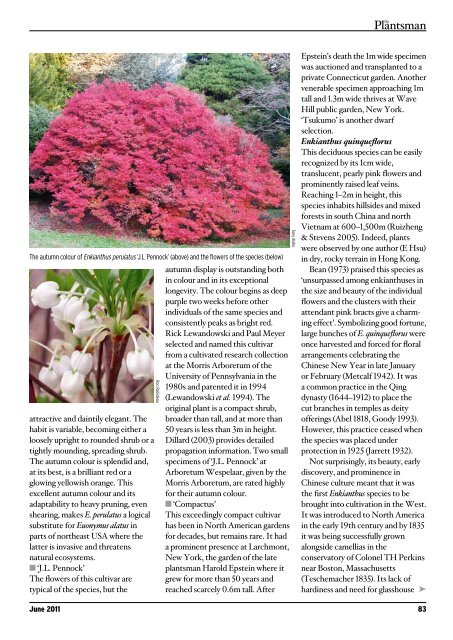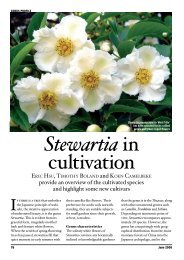Enkianthus - The Polly Hill Arboretum
Enkianthus - The Polly Hill Arboretum
Enkianthus - The Polly Hill Arboretum
Create successful ePaper yourself
Turn your PDF publications into a flip-book with our unique Google optimized e-Paper software.
<strong>The</strong> autumn colour of <strong>Enkianthus</strong> perulatus ‘J.L. Pennock’ (above) and the flowers of the species (below)<br />
attractive and daintily elegant. <strong>The</strong><br />
habit is variable, becoming either a<br />
loosely upright to rounded shrub or a<br />
tightly mounding, spreading shrub.<br />
<strong>The</strong> autumn colour is splendid and,<br />
at its best, is a brilliant red or a<br />
glowing yellowish orange. This<br />
excellent autumn colour and its<br />
adaptability to heavy pruning, even<br />
shearing, makes E. perulatus a logical<br />
substitute for Euonymus alatus in<br />
parts of northeast USA where the<br />
latter is invasive and threatens<br />
natural ecosystems.<br />
n ‘J.L. Pennock’<br />
<strong>The</strong> flowers of this cultivar are<br />
typical of the species, but the<br />
June 2011<br />
Ron Rabideau<br />
autumn display is outstanding both<br />
in colour and in its exceptional<br />
longevity. <strong>The</strong> colour begins as deep<br />
purple two weeks before other<br />
individuals of the same species and<br />
consistently peaks as bright red.<br />
Rick Lewandowski and Paul Meyer<br />
selected and named this cultivar<br />
from a cultivated research collection<br />
at the Morris <strong>Arboretum</strong> of the<br />
University of Pennsylvania in the<br />
1980s and patented it in 1994<br />
(Lewandowski et al. 1994). <strong>The</strong><br />
original plant is a compact shrub,<br />
broader than tall, and at more than<br />
50 years is less than 3m in height.<br />
Dillard (2003) provides detailed<br />
propagation information. Two small<br />
specimens of ‘J.L. Pennock’ at<br />
<strong>Arboretum</strong> Wespelaar, given by the<br />
Morris <strong>Arboretum</strong>, are rated highly<br />
for their autumn colour.<br />
n ‘Compactus’<br />
This exceedingly compact cultivar<br />
has been in North American gardens<br />
for decades, but remains rare. It had<br />
a prominent presence at Larchmont,<br />
New York, the garden of the late<br />
plantsman Harold Epstein where it<br />
grew for more than 50 years and<br />
reached scarcely 0.6m tall. After<br />
Tony Aiello<br />
<strong>The</strong><br />
Plantsman<br />
Epstein’s death the 1m wide specimen<br />
was auctioned and transplanted to a<br />
private Connecticut garden. Another<br />
venerable specimen approaching 1m<br />
tall and 1.3m wide thrives at Wave<br />
<strong>Hill</strong> public garden, New York.<br />
‘Tsukumo’ is another dwarf<br />
selection.<br />
<strong>Enkianthus</strong> quinqueflorus<br />
This deciduous species can be easily<br />
recognized by its 1cm wide,<br />
translucent, pearly pink flowers and<br />
prominently raised leaf veins.<br />
Reaching 1–2m in height, this<br />
species inhabits hillsides and mixed<br />
forests in south China and north<br />
Vietnam at 600–1,500m (Ruizheng<br />
& Stevens 2005). Indeed, plants<br />
were observed by one author (E Hsu)<br />
in dry, rocky terrain in Hong Kong.<br />
Bean (1973) praised this species as<br />
‘unsurpassed among enkianthuses in<br />
the size and beauty of the individual<br />
flowers and the clusters with their<br />
attendant pink bracts give a charming<br />
effect’. Symbolizing good fortune,<br />
large bunches of E. quinqueflorus were<br />
once harvested and forced for floral<br />
arrangements celebrating the<br />
Chinese New Year in late January<br />
or February (Metcalf 1942). It was<br />
a common practice in the Qing<br />
dynasty (1644–1912) to place the<br />
cut branches in temples as deity<br />
offerings (Abel 1818, Goody 1993).<br />
However, this practice ceased when<br />
the species was placed under<br />
protection in 1925 (Jarrett 1932).<br />
Not surprisingly, its beauty, early<br />
discovery, and prominence in<br />
Chinese culture meant that it was<br />
the first <strong>Enkianthus</strong> species to be<br />
brought into cultivation in the West.<br />
It was introduced to North America<br />
in the early 19th century and by 1835<br />
it was being successfully grown<br />
alongside camellias in the<br />
conservatory of Colonel TH Perkins<br />
near Boston, Massachusetts<br />
(Teschemacher 1835). Its lack of<br />
hardiness and need for glasshouse ➤<br />
83



